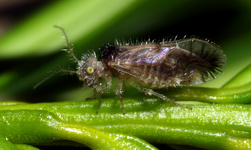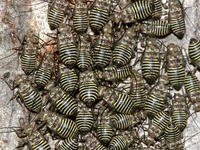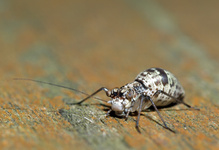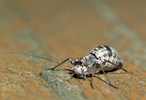Psocomorpha
Bark lice
Emilie Bess and Kevin P. Johnson


This tree diagram shows the relationships between several groups of organisms.
The root of the current tree connects the organisms featured in this tree to their containing group and the rest of the Tree of Life. The basal branching point in the tree represents the ancestor of the other groups in the tree. This ancestor diversified over time into several descendent subgroups, which are represented as internal nodes and terminal taxa to the right.

You can click on the root to travel down the Tree of Life all the way to the root of all Life, and you can click on the names of descendent subgroups to travel up the Tree of Life all the way to individual species.
For more information on ToL tree formatting, please see Interpreting the Tree or Classification. To learn more about phylogenetic trees, please visit our Phylogenetic Biology pages.
close boxIntroduction
Psocomorpha is the largest suborder of bark lice, containing 24 families and nearly 4000 species. Psocomorphids live on tree bark, foliage, or leaf litter and eat lichens, algae, and fungus. These bark lice are 2-12 mm long, and most have full-length wings, but some have short wings or are wingless. Members of this suborder exhibit a range of interesting behaviors including aggregation in large numbers, sound production by stridulation, sub-sociality, nesting, and web spinning.
Characteristics
Synapomorphies
(from Yoshizawa 2002)
- Head:
- Vertex is rounded.
- Maxilla lacks stipito-galeal muscle.
- Thorax:
- Proximal minute process is present at apex of first axillary sclerite.
- Forewings:
- Nodus is present on forewing.
- Pterostigma is thickened.
- Forewing has a hooked nodulus formed by truncated spines fused at their base.
General Characters
(from Yoshizawa 2002)
- Head:
- Vertex is rounded (angled in Calopsocidae).
- Antennae have 13 segments.
- Antennal segments are never annulated (ringed).
- Maxilla lacks stipito-galeal muscle.
- Hypopharyngeal filaments are fused for most of their length.
- Labial palpus has one segment.
- Wings:
- Nodus is present on forewing.
- Pterostigma on forewing is thickened.
- Forewing has a hooked nodulus formed by truncated spines fused at their base.
- Forewing veins CuP and A1 end together with at the wing margin.
- Thorax:
- Apex of first axillary sclerite usually has a minute proximal process.
- Female:
- Subgenital plate lacks median sclerite.
Discussion of Phylogenetic Relationships
The monophyly of Psocomorpha is strongly supported by both morphological and molecular data. Yoshizawa (2002) provided a comprehensive morphological analysis of the suborder, including all 24 families and outgroup taxa from suborders Troctomorpha and Trogiomorpha. He concluded that the suborder is monophyletic, based on the synapomorphic characters listed under Characteristics, and that five infraorders are included in Psocomorpha: Archipsocetae, Caeciliusetae, Epipsocetae, Homilopsocidea, and Psocetae.Molecular analysis by Johnson & Mockford (2003) and Johnson et al. (2004) of four genes (nuclear ribosomal gene 18S and mitochondrial genes 12S, 16S, and COI) provided strong support for Psocomorpha and for the monophyly of four of Yoshizawa's infraorders, excluding Homilopsocidea. Analysis of 18S placed Psocomorpha in a sister relationship to "Suborder Troctomorpha" (not monophyletic) and the parasitic lice (Johnson et al. 2004).
References
Johnson, K. P. & E. L. Mockford. 2003. Molecular systematics of Psocomorpha (Psocoptera). Systematic Entomology 28: 409-40
Johnson, K. P., K. Yoshizawa, and V. S. Smith. 2004. Multiple origins of parasitism in lice. Proceeding of the Royal Society of London B 271: 1771-1776.
Lienhard, C. and C. N Smithers. 2002. Psocoptera (Insecta) World Catalogue and Bibliography. Muséum d'Histoire Naturelle, Geneva, Switzerland.
Mockford, E. L. 1993. North American Psocoptera (Insecta). Gainesville, Florida: Sandhill Crane Press.
Mockford, E. L. 2005. Order Psocoptera: Psocids. Pp. 341-355 in C. A. Triplehorn and n. F. Johnson (eds.) Borror and DeLong's Introduction to the Study of Insects. Belmont, California: Thomson Publishing.
Smithers, C. N. 1996. Psocoptera. Pp. 1-80, 363-372 (Index) in A. Wells (ed.) Zoological Catalogue of Australia. Vol. 26. Psocoptera, Phthiraptera, Thysanoptera. Melbourne: CSIRO Publishing, Australia.
Yoshizawa, K. 2002. Phylogeny and higher classification of suborder Psocomorpha (Insecta: Psocodea:'Psocoptera'). Zoological Journal of the Linnean Society 136: 371-400.
Yoshizawa, K. 2005. Morphology of Psocomorpha (Psocodea: 'Psocoptera'). Insecta Matsumurana 62: 1-44.
Information on the Internet
- Psoco Net: The Psocidologists' Home Page. The latest information on Psocoptera taxonomy and reserchers in the Psocoptera community, maintained by Dr. Kazunori Yoshizawa, Hokkaido University, Sapporo, Japan.
- Psocoptera (Insecta) World Catalogue and Bibliography
- Discover Life: Psocoptera Page
- Dr. Charles Lienhard. Psocid expert at the Natural History Museum, Geneva, Switzerland.
- Dr. Edward Mockford. Expert on Psocids of North America and beyond, Illinois State University.
- Dr. Kevin Johnson. Expert on molecular systematics of Psocids and parasitic lice, Illinois Natural History Survey.
- Emilie Bess. Research on Psocids of Hawaii and elsewhere, University of Illinois.
Title Illustrations

| Scientific Name | Matsumuraiella radiopicta |
|---|---|
| Location | Japan |
| Specimen Condition | Live Specimen |
| Identified By | K. Yoshizawa |
| Life Cycle Stage | adult |
| View | lateral |
| Size | 3mm |
| Copyright | © 2006 Kazunori Yoshizawa |
| Scientific Name | Cerastipsocus venosus |
|---|---|
| Location | Jaffrey, NH |
| Comments | 8/13/2004 |
| Specimen Condition | Live Specimen |
| Behavior | aggregation |
| Life Cycle Stage | adult |
| View | dorsal |
| Copyright | © Tom Murray |
| Scientific Name | Mesopsocus unipunctatus |
|---|---|
| Specimen Condition | Live Specimen |
| Identified By | K. Yoshizawa |
| Sex | Female |
| Life Cycle Stage | micropterous adult |
| View | anterolateral |
| Size | 3mm |
| Copyright | © 2006 Kazunori Yoshizawa |
About This Page
Emilie Bess

Illinois Natural History Survey, Champaign, Illinois, USA
Kevin P. Johnson

Illinois Natural History Survey, Champaign, Illinois, USA
Correspondence regarding this page should be directed to Emilie Bess at
bess@inhs.uiuc.edu
and Kevin P. Johnson at
kjohnson@inhs.uiuc.edu
Page copyright © 2009 Emilie Bess and Kevin P. Johnson
All Rights Reserved.
- First online 09 October 2006
- Content changed 25 March 2009
Citing this page:
Bess, Emilie and Kevin P. Johnson. 2009. Psocomorpha. Bark lice. Version 25 March 2009 (under construction). http://tolweb.org/Psocomorpha/30218/2009.03.25 in The Tree of Life Web Project, http://tolweb.org/











 Go to quick links
Go to quick search
Go to navigation for this section of the ToL site
Go to detailed links for the ToL site
Go to quick links
Go to quick search
Go to navigation for this section of the ToL site
Go to detailed links for the ToL site